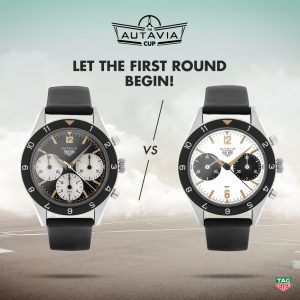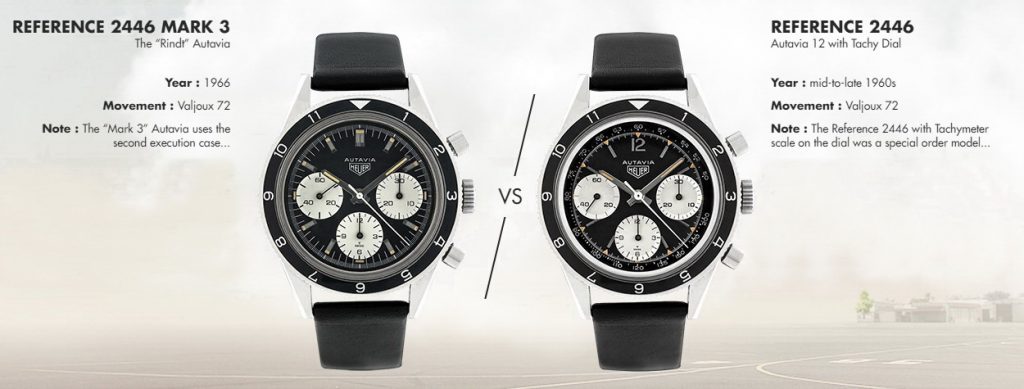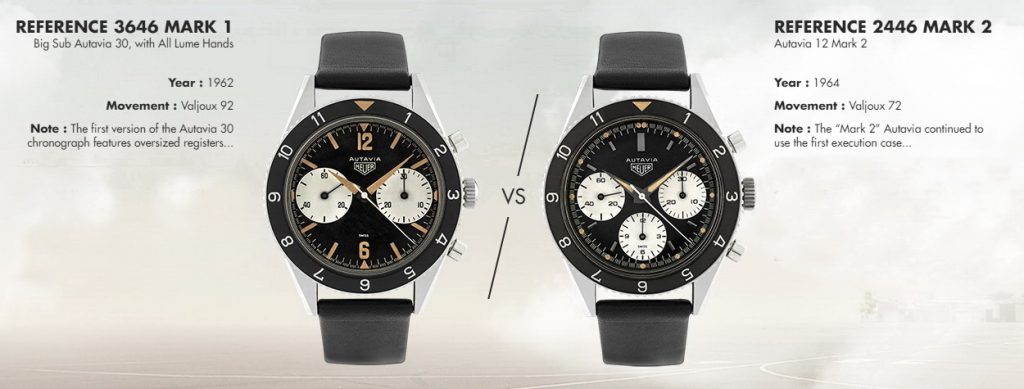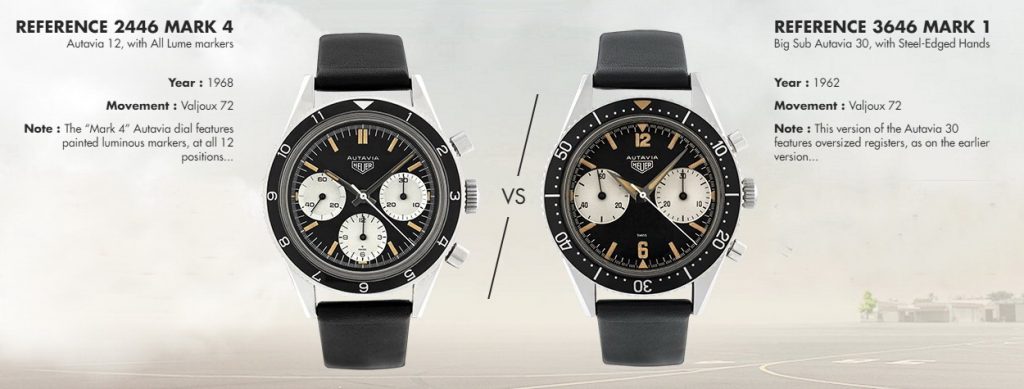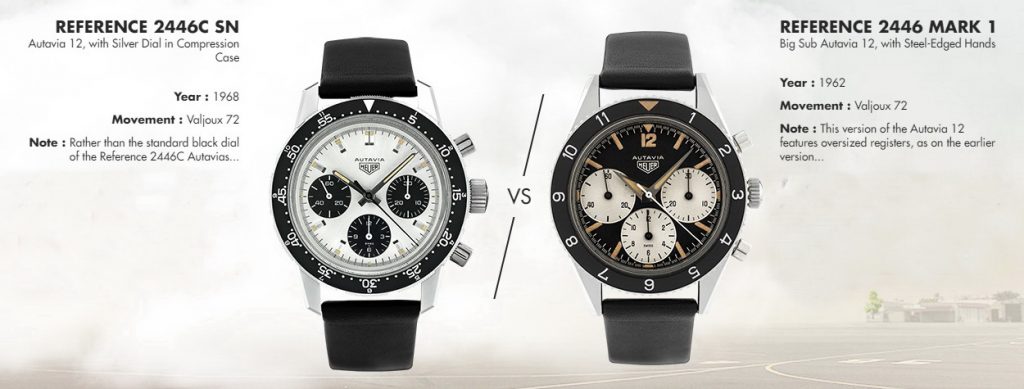Today, TAG Heuer has launched the Autavia Cup competition, a month-long event in which enthusiasts will cast votes to determine which Autavia the company will re-issue in 2017. The competition consists of a series of head-to-head, knock-out matches, in which each winning model will advance to the next round of the competition. Sixteen Autavias are included in the competition, 12 of them being historic models produced by Heuer in the 1960s and 4 of them being newly-created, as Fantasy Autavias, for purposes of the Autavia Cup. After enthusiasts have narrowed the field to four Autavias, TAG Heuer will select the model to the re-issued. Visit the Autavia Cup website to cast your vote!
This posting will serve as a Guide to the Autavia Cup, highlighting the key features of each of the 16 competing models. Click on the [High Res] link at the end of each description to see high resolution photos of each of the models. For comprehensive information about the Autavias from the 1960s (and the 1970s and 80s, as well), you will want to see the book, Heuer Autavia Chronographs 1962-85, by Richard Crosthwaite and Paul Gavin. Paul supplied the photos for the Autavia Cup competition and also created the four “Fantasy” models. You can order the book HERE.
The Historic Autavias — Matches 1 through 6
The first six Matches in the Autavia Cup competition include 12 Autavias introduced by Heuer during the period from 1962 to 1969. Each of these models is a manual-winding model, powered by the Valjoux 72 or Valjoux 92 movement, that uses a stainless steel case with a rotating bezel.
Match 1 — “Rindt” vs. Three Register Tachymeter Dial
On the Left — This is the three-register version of the Autavia, as worn by Formula One World Champion, Jochen Rindt. The Mark 3 dial uses polished steel markers, rather than the luminous markers of the earlier models. Collectors praise the perfect proportions of this model, with the thinner bezel and smaller registers than the first Autavias. [High Res]
On the Right — This is a special order version of the Autavia, with a Tachymeter scale on the dial. The tachymeter scale is the ultimate racer’s tool, converting elapsed time over a measured distance into the racer’s speed (for example, the time over a measured mile is converted into miles per hour). Heuer offered these special order dials in the mid-to-late 1960s. [High Res]
The Winner — This was the closest of the first round matches, with the “Rindt” beating out the three-register Tachymeter Autavia, by a tally of 54% / 46%.
Match 2 — Two Register Tachymeter Dial vs. “Andretti”
On the Left — This is the special order Autavia, with the Tachymeter scale on the dial (as in Match 1), except that this model has two registers rather than three. Some enthusiasts prefer the symmetry and open space provided by the two-register arrangement. [High Res]
On the Right — Just as Match 1 paired the three-register Autavia worn by Jochen Rindt against the three-register Tachymeter model, here we see the two register model worn by Mario Andretti. Andretti won both the Indianapolis 500 and the Formula One World Championship, and went on to wear the 18 karat gold Carrera worn by the Ferrari drivers. We see many photos of him wearing this Autavia while racing! [High Res]
The Winner — We saw the three-register “Rindt” beat out the three-register version of the Tachymeter dial Autavia in Match One (above), and here we saw the two-register “Andretti” beat out the two-register version of the Tachymeter Autavia, by a 56% / 44% vote. So now we have the two “Mark 3” models set for a face-off in the Second Round.
Match 3 — Big Sub (2 Register) vs. Mark 2 Dial
On the Left — This is the very first of the Autavias, from 1962. Signature elements include the oversized registers (which collectors call the “Big Subs”) and the dauphine hands, entirely covered in luminous material (called “All Lume”). This model is sought after by collectors as the original Autavia chronograph. [High Res]
On the Right — This is the second version of the Autavia dial (Mark 2), as standard size registers replace the previous oversized Big Subs, and we have a combination of luminous dots and applied metal markers for the hours. This model seems to have had a relatively short production run, and is cherished by today’s collectors for its beautiful design. [High Res]
The Winner — The only representative of the Mark 2 Autavias came through with a solid win, with a 61% / 39% tally. The voters seem to want three registers in the re-issue of the Autavia.
Match 4 — All Lume vs. Big Sub (2 Register)
On the Left — This is the fourth version of the Autavia dial (Mark 4) and features luminous markers for each of the hours, rather than a combination of numerals and luminous markers, as on the first execution of the Autavia. This version is exceptionally rare, and evokes the warm glow of the Autavia’s luminous paint, contrasted with the black dial. [High Res]
On the Right — This Mark 1 model has the oversized registers of the very first model (Big Subs), but the hands now have steel edges and luminous inserts (rather than the predecessor “All Lume” hands). The polished steel hands give this model a special brightness, compared with the softness of the earlier hands. [High Res]
The Winner — The Mark 4 (All Lume) Autavia is a rare model, but proved popular with today’s voters, winning the match 55% to 45%.
Match 5 — Big Sub (3 Register) vs. Compressor Case
On the Left — The origin of the species — this is the very first version of the three register Autavia chronograph, from 1962. Defining elements include the oversized registers (“Big Subs”) and the hands covered entirely in luminous material “All Lume”). Jack Heuer has emphasized the importance of the hour recorder for rally timing, making this Autavia a favorite of the racers. [High Res]
On the Right — Around 1968, Heuer switched the construction of the Autavia case, moving from the previous screw-back models to the snap-back “compressor” model. This traditional model, with a black dial and white registers, is one of the two “compressor” models included in the Autavia Cup competition. [High Res]
The Winner –– Observers called this result an “upset”, as the Reference 2446C (Compressor) defeated the early “Big Subs” model, by a 62% / 38% vote.
Match 6 — “Panda” vs Big Sub (3 Register)
On the Left — This is the only “Panda” version of the Autavia made by Heuer in the 1960s, but the story is not that simple. Evidence suggests that Heuer ordered the dials, but that the watch never went into full production. Collectors who have been fortunate enough to find the dials have completed several of these watches, and they are among the most sought-after in today’s market. [High Res]
On the Right — This Mark 1 model has the oversized registers of the very first model, but the hands now have steel edges and luminous inserts (rather than the previous “All Lume” hands). The polished steel hands give this model a special brightness, compared with the softness of the previous hands. [High Res]
The Winner –– Not much of a surprise here, as the “Panda” model defeated the “Big Subs”, by a 67% to 33% vote. The Reference 2446C SN “Panda” received the second highest number of votes in Round One of the Autavia Cup.
The “Fantasy” Autavias — Matches 7 and 8
Matches 7 and 8 of the first round involve four “Fantasy” Autavias — models created by Paul Gavin, by changing the colors of the dials and registers of historic models. With the four Fantasy Autavias occupying a single bracket, we can be certain that one of the models will make it through to the “Final Four”.
Match 7 — Fantasy “Panda” vs. Black-Out Big Sub
On the Left — This Fantasy Autavia is based on the Mark 3 “Rindt” model, but the dial has been reversed, from black to white, and the registers have been reversed, from white to black, to give us the first of three “Panda” Autavias. Carreras of the period and Autavias produced from and after 1969 used this approach, and it is fascinating to see what the 1960s Autavias would have been like using this scheme. [High Res]
On the Right — All the Autavias of the 1960s had contrasting dials and registers, but one of the most beautiful Carreras of the period featured black registers on a black dial. Extending this scheme to the Autavia produces a dramatic “black-out” effect, especially given the contrast between the warm tone of the lume and the black dial and bezel. This is the only black-on-black Autavia in the Autavia Cup, so if you like this color scheme, this one should get your vote! [High Res]
The Winner — Not much of a battle here, as the “Panda” model defeated the “black-out” Autavia, by a vote of 64% to 36%. Voters in the Autavia Cup are making the statement that the next Autavia should be a “Panda” model.
Match 8 — Fantasy “Panda” — 2 or 3 Registers
On the Left — In Match 8, we see a pairing of two Big Sub Autavias, both of them reversed from black dials with white registers, to create “Panda” models. The Fantasy Autavia on the left is a two-register model, with All Lume hands, as used on the very first Autavias. [High Res]
On the Right — Our last competitor is another Fantasy “Panda” Autavia, this one being an early three-register model with its Big Subs. Many collectors believe that Heuer “got it right” the first time, with these early Autavias. Now, we can vote for this early version, modified for the “Panda” scheme. [High Res]
The Winner — This Fantasy creation — the Panda version of the “Big Subs” Autavia — received the highest number of votes in Round One of the Autavia Cup, with a 70% / 30% victory. Round One of the Autavia Cup confirmed that the enthusiasts like the Pandas and they like the three register models, and this one has both these popular features.
+++++++++++++++++++++++++++++++++++
Jeff Stein
March 17, 2016; updated to include results of voting

